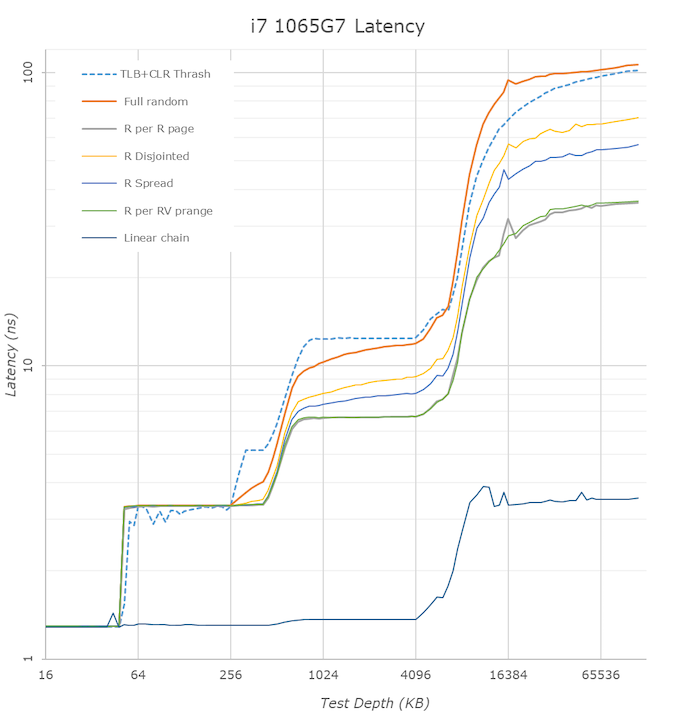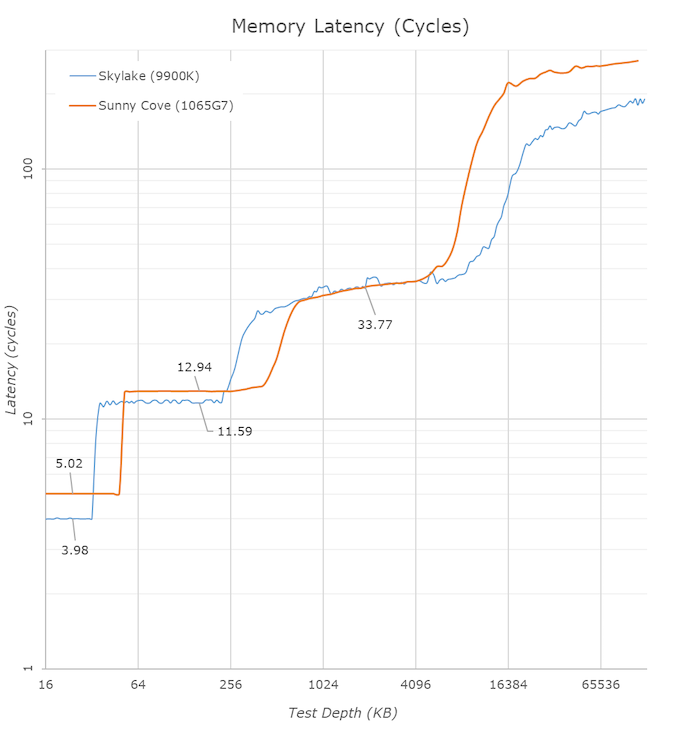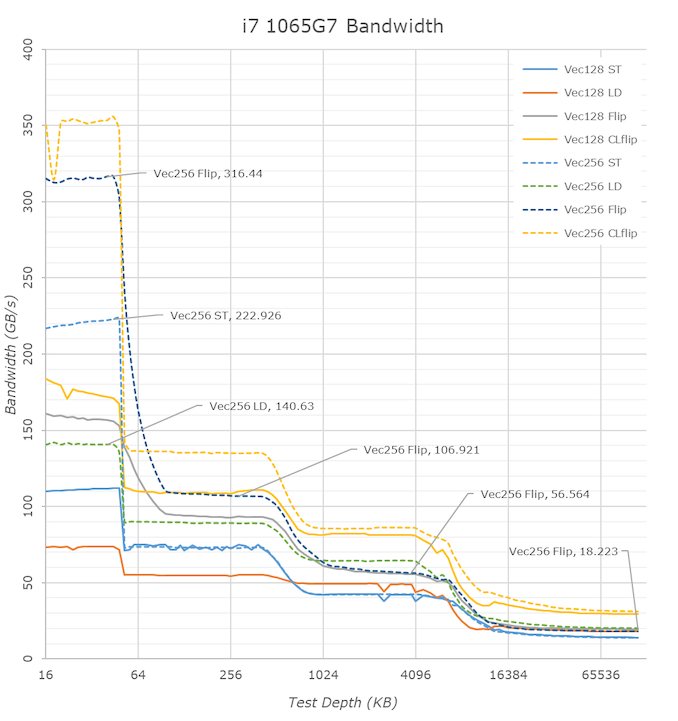The Ice Lake Benchmark Preview: Inside Intel's 10nm
by Dr. Ian Cutress on August 1, 2019 9:00 AM EST- Posted in
- CPUs
- Intel
- GPUs
- 10nm
- Core
- Ice Lake
- Cannon Lake
- Sunny Cove
- 10th Gen Core
Cache and TLB Updates
One of the biggest changes in the new Sunny Cove core is the cache hierarchy. Throughout most of the last decade, Intel has kept the same cache configuration among its server cores with very few changes, aside from improving the micro-op cache through Sandy Bridge today, but with Sunny Cove, we get some key updates.
From our microarchitecture disclosure article, we know that Sunny Cove brings with it an increased L1 data cache, as well as a doubled L2 cache, from Skylake. With this comes more associativity as well.
| Core Cache Comparison | ||||||
| Sunny Cove |
AnandTech | Cannon Lake |
Skylake | Sandy Bridge |
AMD Zen 2 |
|
| 48 KB 12-way |
L1-D | 32 KB 8-way |
32 KB 8-way |
32 KB 8-way |
32 KB 8-way |
|
| 32 KB 8-way |
L1-I | 32 KB 8-way |
32 KB 8-way |
32 KB 8-way |
32 KB 8-way |
|
| 512 KB 8-way |
L2 | 256 KB 4-way |
256 KB 4-way |
256 KB 8-way |
512 KB 8-way |
|
| 2 MB 16-way |
L3/core | 2 MB 16-way |
2 MB 16-way |
2MB 16-way |
4 MB 16-way |
|
| 2304 | uOp Cache | 1536 | 1536 | 1536 | 4096 | |
I’ve also included the size of the micro-op cache in this comparison, because we understand that the L1-I and the micro-op cache are typically located next to each other in the die design – increasing the size of one typically means limiting the size of the other, however given that both of them work to accelerate the same types of data, it is important to find the right balance: AMD for Zen 2 decided to halve the L1-I and double its associativity, and then double the micro-op cache from 2k to 4k entries. For Sunny Cove, Intel has increased the L1-D by 50%, but also increased the micro-op cache by 50%, taking advantage of the second generation 10nm process.
In the above latency graph comparison, we can notably see the new increased cache capacities. The L1’s increase from 32KB to 48KB is well visible, as well as the L2 increase from 256KB to 512KB.
On the part of the L2 it’s interesting to see that again the new core’s TLB structures don’t quite cover the whole capacity of the L2 and that’s why the latter half of the L2 has worse access latencies for L1D TLB miss patterns.
L3 latencies look similar, however we’ll dwell into that just in a bit. The DRAM latencies of course are apples and oranges in this case as Intel’s new LPPDR4X memory controller in the new ICL part doesn’t have a counter-part we can compare to, but as expected the memory latency is notably worse than a desktop part so no big surprises there.
What’s rather disappointing however is that we’re not really seeing any kind of change to the prefetchers and our access patterns between the two microarchitectures look identical. We had expected Intel to improve in this regard, but alas it seems, at least for our test cases, there’s been no improvements.
One of the major balancing acts with cache sizes is also cache latency. The bigger the cache, the longer it takes to retrieve data from it – increasing associativity can do this as well. Intel for the longest time has cited a 4-cycle latency to its L1 cache, and a 12-cycle latency to its L2 cache. This changes, in quite a substantial way.
| Core Cache Latency (in cycles) | ||||||
| Sunny Cove | AnandTech | Cannon Lake |
Skylake | Sandy Bridge |
AMD Zen 2 |
|
| 5 | L1 | 4 | 4 | 4 | 4 | |
| 13 | L2 | 12 | ~12 | 12 | 12 | |
| 30-36 | L3 | 26-37 | 34 | |||
Due to the increase in the L1 cache, that 4-cycle latency is now a 5-cycle latency. Intel is hoping that its double L1 store bandwidth will help hide that latency, however adding 20% latency onto every data fetch is a heavy hit to take. This is why a lot of the rest of the core is also beefed up, so work can still continue to cover for this extra cycle. It is worth noting that Intel’s Atom cores in the past had an L1 latency of 3 cycles, however they have also since moved to 4-cycle.
The L2 also changes, from 12 cycles to 13 cycles. You can’t double a cache for free, and it is interesting to note here that now AMD and Intel share the same L2 cache size and the same associativity, however AMD has a cycle advantage on Intel. This has a knock on effect for L3 cache latency too, which has increased from ~26-37 cycles to ~30-36 cycles on Intel, from Skylake. The latency here isn’t uniform because the cache isn’t uniform, and accessing non-local L3 slices comes with a latency penalty, as say opposed to AMD’s uniform latency L3.
One of the biggest additions Intel was keen to make in our Sunny Cove microarchitecture disclosure is the increase in the L1 bandwidth. Based on our testing, Skylake’s L1 data cache was capable of 2x32-byte read and 1x32-byte write per clock. For Sunny Cove this has increased, but it gets a bit more complicated. In one clock Sunny cove can perform 2x64-byte reads and either 1x64-byte write, or 1x32-byte write, or 2x16-byte writes. So both reads and writes, at peak, have doubled with bit width, with the write configurations being a bit more complex.
We can see the direct effects of the bandwidth change in our bandwidth tests. The L1 store bandwidth is extremely evident as it measures in at 222GB/s on the ICL part, while only reaching 139GB/s on the 28% higher clocked 9900K. If we normalise for frequency, we indeed see a doubling of the store bandwidth of the new core.
The L2 cache bandwidth looks unchanged from Skylake – the part here lags behind with an equal amount to the frequency difference. Surprisingly, the L3 bandwidth fares quite well here and is almost at parity to the desktop 9900K even though the frequency difference. The DRAM bandwidth is inferior on the ICL mobile chip, but again that’s to be expected due to the apples and oranges DRAM architecture comparison.
Moving on to the TLB configurations, and it turns out that Intel has moved where this data is stored. This data is typically stored in CPUID.02h, however it is now found in CPUID.18h, and the info between different page sizes and capabilities is now given as subdivisions. The TLBs look as follows, and broken down into configurations:
| Sunny Cove TLB | |||
| AnandTech | Type | Entries | Associativity |
| L1-D | 4K | 64 | 4-way |
| L1-D | 2M | 32 | 4-way |
| L1-D | 1G | 8 | full |
| L1-I | 4K+2M | 8 | full |
| L1-I | 4K+2M+1G | 16 | full |
| L2 | 4K+2M | 1024 | 8-way |
| L2 | 4K+1G | 1024 | 8-way |
This means that for 4K and 2M L1-I entries, there are a total 8+16 = 24 possible, but only 16 1G possible. For 4K L2 entries, there are 1024 + 1024 = 2048 entries possible, however only 1024 each of 2M/1G are possible. The peak numbers align with what Intel has told us in our microarchitecture disclosure, however it is good to dive into what is possible.













261 Comments
View All Comments
Ian Cutress - Thursday, August 1, 2019 - link
I'm encouraging the behaviour. I've been on at Intel to do something like this for a while. I'm giving credit where credit is due. As always with events like this companies like Intel have PR saying they want to do something, and the legal side of the equation resisting. If we get more opportunities like this in the future, it helps us provide a richer content base in advance of a product launch - people get to prepare in case they're in the mood for a purchase.Also, tell me if you say the same things on our Qualcomm QRD testing. Please.
brakdoo - Thursday, August 1, 2019 - link
You are just trying to get an edge over other sites but you are just being played.It's the same BS with Qualcomm and their mmWave BS that has been spread by sites like this. Now 5G is just sub-6 and the only important part is massive MIMO
brakdoo - Thursday, August 1, 2019 - link
"and are for the best part thermally unconstrained"Just wait for the real release and do real testing. Don't you think Intel can release SPEC and Cinebench benchmarks themselves?
They just want you to do cheap advertisement months in advance.
Ian Cutress - Thursday, August 1, 2019 - link
We do our own validation of the platform to remove as much Intel involvement as possible. Also, if Intel went ahead and provided a system that performed vastly different, when it comes time to testing the actual systems, we'll be beating them over the head with the data and making a big stink. Everyone would.The question is, do you trust AnandTech to accurately and fairly test a reference system as if it were an OEM sample? So far your answers would seem to suggest no.
brakdoo - Thursday, August 1, 2019 - link
What I'm asking myself: Did we really learn something new from this piece? Not really would be my answer.Intel explained most of it before and we have seen enough leaks of the XPS 13 2-in-1 and the HP Spectre. Even Geekbench showed us that these CPUs have roughly the speed of 8565u on average (higher IPC, lower freq).
A journalist should always have a professional distance to these companies. This type of conflict of interest used to be most prominent in automobile magazines but the tech/PC companies are stepping up their marketing game.
Moizy - Thursday, August 1, 2019 - link
Dude. Before release, before we would have to wait for products on shelves, Ian got a chance to go inside Intel and test and upcoming product. And he wasn't handed benchmark results, he wasn't told what to report, he was allowed to run largely independently his own standardized benchmark suite. So now, 3-6 months before laptops will be available, we have a preview of what performance will look like. I learned a ton from Ian's preview article, and from this benchmarking piece. I'm not an Intel fan, I'm an industry fan, and this was awesome. Please take your toxicity elsewhere, or better yet, cure yourself of it.Ian, you're a good sport to participate in the comments section, but please don't let "brakdoo" or others pull you down. This was stellar work that I truly appreciate, as I'm sure most readers here do. I come to Anandtech specifically because of the high capabilities, understanding, and integrity of its writers and editors. Have been doing so for over 10 years. Please keep it up.
Dennis Travis - Thursday, August 1, 2019 - link
Well said Moizy. I was about the post the same basic thing. Good job Ian.eastcoast_pete - Thursday, August 1, 2019 - link
+1 on that comment. If company X let's you take a close first look AND bring your own tools I.e. test suite, Ian (and Andrei) would be fools not to take company X up on that offer. Yes, of course Intel has an agenda here, as does any other business, but we know that. In this case, I suspect that Intel wanted to show that Ice Lake actually exists and all parts are working, including the iGPU, unlike Whiskey Lake.MrSpadge - Thursday, August 1, 2019 - link
Well said Moizy, I totally agree! And would like to add: "haters gonna hate!"PreacherEddie - Thursday, August 1, 2019 - link
+1